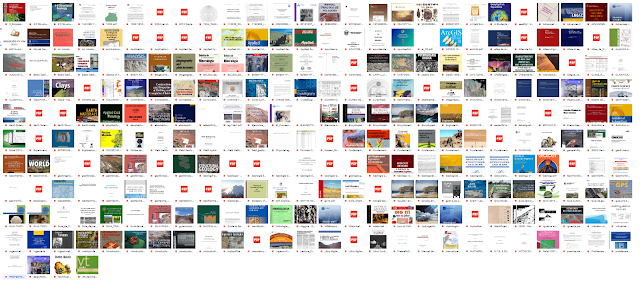martes, 18 de junio de 2019
GEOLOGICAL FIELD TECHNIQUES/ TECHNIQUES DE CHAMP GEOLOGIQUE
Department of Earth and Environmental Sciences,
The Open University, Walton Hall, Milton Keynes, UK
Edited by Angela L. Coe
Authors:
Angela L. Coe
Tom W. Argles
David A. Rothery
Robert A. Spicer
Working in the fi eld contributes a crucial element to our knowledge and understanding of Earth processes, whether it is the prediction of volcanic eruptions, understanding periods of past climate change recorded in sedimentary deposits, deciphering an episode of mountain building, or working out where to fi nd mineral resources. Without primary fi eld data and geological samples of the highest quality, further scientifi c study such as sophisticated isotope measurements or the reconstruction of past life assemblages and habitats is at best without context, and at worst, completely meaningless.
Geological fi eldwork can be both fun and challenging. It provides the chance to work outdoors under a range of conditions and to explore our natural world. It also provides an often unparalleled opportunity to travel and visit localities as more than a tourist. Indeed it often takes you to unspoilt parts of the world that tourists rarely penetrate. Almost all fi eldwork enables us to work as part of a team, often with international partners, and this can be one of the most rewarding experiences of being a geologist because we can learn from each other. Many long - term friendships have been forged through geological fi eldwork.
This book is aimed primarily at undergraduates studying geology and Earth sciences. It will also potentially be of use to engineers, archaeologists and environmental scientists who need to collect information on the bedrock. The increasingly multidisciplinary nature of science will make the text useful to masters, doctoral and professional scientists who do not have a background in practical geology or Earth science. The book is non - site specific and includes examples from around the world. There are chapters covering data collection from igneous, metamorphic and sedimentary rocks as well as specifi c chapters on palaeontological and structural data collection. It also deals with the basics of geological mapping.
The book assumes a basic understanding of the main concepts and theory in geology. It assumes that the reader is familiar with: the major rock - forming minerals, how to identify minerals in hand specimen, rock classifi cation, geological processes and common geological terms. The further reading lists at the ends of the chapters provide a selection of introductory geological texts as well as more specialist ones. In addition there are appendices summarizing key geological features and classifi cation schemes.
There is also an accompanying website ( www. wiley.com/go/coe/geology ) with all of the fi gures, tables, links to other websites and other material. Reviews of the original book proposal suggested expansion of certain chapters and even the deletion of others, however, none of the reviewers agreed on which chapters these should be so clearly it is a matter of personal preference.We have therefore kept to the broad overview, and refer the reader to more specialist fi eldwork texts that are available, and hope that this book inspires others to write textbooks on more specifi c fi eldwork topics that are not available.
Writing a book on fi eld techniques has long been an ambition of mine; the style and organization has had a lengthy gestation period during many months of fi eldwork, both as a researcher and a university lecturer. I am delighted that when I was eventually able to spend some time completing this task I was joined by a number of colleagues who had expertise that complemented my own; it has been a pleasure to work with them. I would like to thank all the colleagues, PhD students and undergraduate students that I have worked with. My experience of being with them in the fi eld has helped me to shape this book. Wishing you both enjoyable and highly productive fi eldwork.
Seguidores
GEOFIELD FANPAGE
Entradas Populares
-
MANUAL DE FOTOGEOLOGIA Publicaciones cientificas de la junta de energia nuclear *M. L. LOPEZ VERGARA Fotogeólogo al servicio de l...
-
Depósitos epitermales de alta y baja sulfuración: una tabla comparativa Antoni Camprubí*, Eduardo González-Partida, Gilles Levresse J...
-
Subdivisión de la Placa de Nazca en tres nuevas placas tectónicas y su incidencia con la sismicidad peruana actual* Subdivision of th...
-
MANUAL DE EVALUACION Y DISEÑO DE EXPLOTACIONES MINERAS MADRID 1997 *MANUEL BUSTILLO REVUELTA Doctor en Ciencias Geológicas F...
-
METAMORFISMO Apuntes de la asignatura Petrología Endógena II (Móduo I) *Javier Gómez Jiménez 2006 Metamorphism: a proc...
-
MANUAL DE PROCEDIMIENTON PARA EL REGISTRO GEOTECNICO DE SONDAJES PROYECTO EL CHOCO ESTADO DE BOLÍVAR, VENEZUELA Este docume...
-
LIBROS DE GEOCIENCIAS + DE 500(PRIMERA PARTE) GEOFIELD Comparte la primera parte de LIBROS DE GEOCIENCIAS. Son mas de 500 libros ...
Categories
- DESCARGAS (66)
- GEOLOGIA DE YACIMIENTOS MINERALES (23)
- GEOLOGIA DE CAMPO Y MINAS (19)
- GEOLOGIA ESTRUCTURAL (19)
- PROYECTOS MINEROS (11)
- GEOLOGIA GENERAL (9)
- GEOESTADISTICA - GEOFISICA - SISMOLOGIA - GEOQUIMICA (8)
- GEOMORFOLOGIA (8)
- METALOGENIA (7)
- MINERALOGIA Y CRISTALOGRAFIA (7)
- SEDIMENTOLOGIA Y ESTRATIGRAFIA (7)
- PETROLOGIA IGNEA Y METAMORFICA (5)
- GEOLOGIA DEL PERU (4)
- GEOTECNIA (3)
- GEOTECNIA MINERA (3)
- ESTABILIDAD DE TALUDES (2)
- FOTOGEOLOGIA (2)
- GEOTECTONICA (2)
- BIENVENIDO (1)
- GEOLOGIA DE LOS HIDROCARBUROS (1)
- HIDROGEOLOGIA (1)
- MECANICA DE ROCAS (1)
- PÁGINAS DE GEOCIENCIAS Y MINERÍA (1)
- TOPOGRAFIA MINERA (1)
- VULCANOLOGIA (1)
Blog Archivo
Buscar este blog
Blogroll
ACERCA DE
Con la tecnología de Blogger.
GEOFIELD

GEOFIELD PERU
BUSCAR
LIBROS DE GEOCIENCIAS + DE 500(PRIMERA PARTE)
LIBROS DE GEOCIENCIAS + DE 500(PRIMERA PARTE) GEOFIELD Comparte la primera parte de LIBROS DE GEOCIENCIAS. Son mas de 500 libros ...

Entradas populares
Copyright ©
GEOFIELD | Powered by Blogger
Design by Flythemes | Blogger Theme by NewBloggerThemes.com





























0 comentarios:
Publicar un comentario